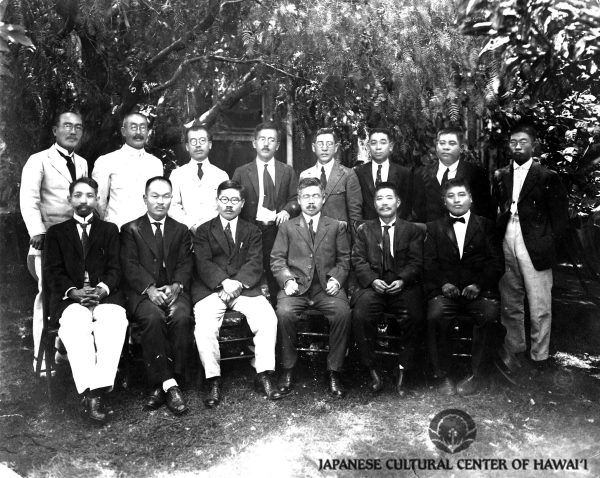Group Media & Photos

Maui Nikkei Community Members, ca. 1925. Front Row (L-R): Gunsuke Yasui (1st), Katsuichi Kawamoto (2nd), Dr. Seiichi Ohata (3rd), Dr. Koshiro Tofukuji (4th), Hisahi Ito (5th or 6th). Back Row: Nagao Otsuka (2nd), Miyamoto (3rd), Dr. Yukihide Kohatsu (4th), Jiro Fujiyoshi (5th), Tomoeda (6th), Yasujiro Matsuda, Dr. Kohatsu's driver (7th), Matsuzo Kozaki (8th). JCCH/Takuzo Kawamoto Collection.
Arrested: December 1941
Kilauea Military Camp, Hawaii Island
Sand Island Internment Camp, Honolulu, Oahu Island
A group of 167 Hawaii men (mostly Issei) were sent on the second transfer ship for internment in U.S. Army and Department of Justice camps on the Mainland. Together, the men were sent from camp to camp.
In June 1943, this transfer group was split into two, with this group sent directly from Camp Livingston to the Santa Fe Camp.
From there, some internees were paroled to War Relocation Authority camps, where they were reunited with family members. Others were transferred for repatriation to Japan.
Angel Island Detention Facility, California
March 1942 - April 1942
Fort Sill Internment Camp, Oklahoma
April 1942 - May 1942
Camp Livingston Internment Camp, Louisiana
June 1942 - June 1943
Santa Fe Internment Camp, New Mexico
June 1943 - September 1943
Repatriated to Japan: September 1943
Included among the repatriates who left from New York on the M.S. Gripsholm were 72 Hawaii internees and their families.
A pioneering immigrant physician, Koshiro Tofukuji opened in Honoka'a in 1907 the first Japanese hospital on Hawaii Island. Trained in Tokyo and later at the University of Michigan, Tofukuji also was a veteran of the Japanese imperial medical corps during the Russo-Japanese war.
When World War II broke out and Tofukuji was interned, his property in Honoka'a was frozen by the U.S. government and later seized and sold at auction.
Tokufuji's sons followed him into medical practice, with two sons also serving in the U.S. military. Shinobu Tofukuji, a pharmacist in Wailuku, Maui, was a member of the 100th Infantry Battalion's medical corps and then the 442nd Regimental Combat Team. Youngest son Frank Takashi Tofukuji volunteered for the U.S. Army in 1946 and served with the 441st Counterintelligence Corps in Tokyo during the U.S. Occupation.
